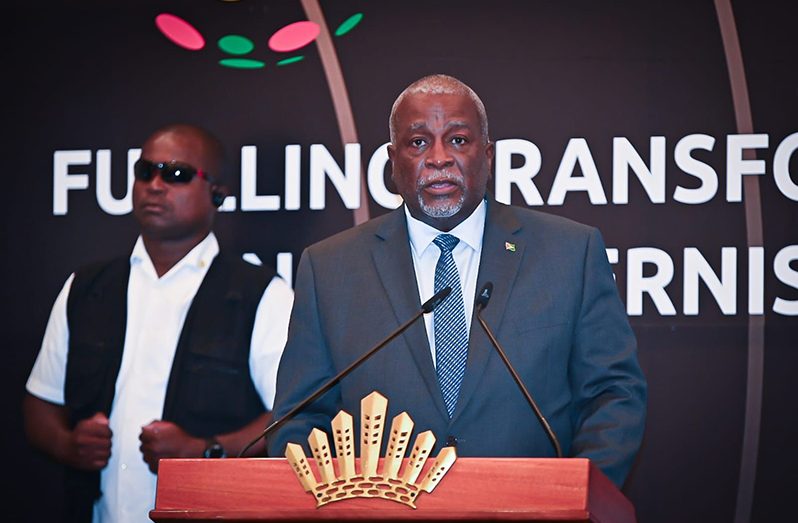– says clean energy pivotal to Guyana’s energy transformation, sustainability goals
IN the midst of a significant global transition, Guyana is charting a transformative course away from conventional energy practices and towards a future powered by clean and sustainable sources. This shift is driving the country towards becoming a net exporter of energy.
“Clean energy is pivotal in Guyana’s energy transformation and long-term sustainability goals,” Prime Minister Brigadier (Ret’d) Mark Phillips reaffirmed during his address on the third day of the Guyana Energy Conference and Supply Chain Expo, hosted at the Marriott Hotel in Kingston.
Prime Minister Phillips, who is responsible for the energy sector, highlighted that there is no need for a trade-off between transitional and transformative energy solutions, reinforcing the nation’s commitment to a sustainable and environmentally friendly future.
Against this backdrop, the Prime Minister highlighted the government’s adoption of robust policies, cost-effective technologies, and energy-efficient solutions.
These initiatives, he pointed out, aims to provide equitable and affordable access to clean and renewable energy, reducing the country’s reliance on imported fossil fuels.
The Prime Minister detailed the strides made through the Low Carbon Development Strategy (LCDS) 2030, which focuses on employing innovative clean energy solutions using natural resources for national benefit.
He explained that significant infrastructure investments are being made, including the development of the energy sector, healthcare services, and the diversification of the agriculture sector.
According to him, Guyana is preparing for an anticipated increase in electricity demand within the next five years, positioning natural gas as a transitional fuel.
This is part of a broader strategy to expand renewable energy capacity, particularly solar PV, hydropower, and wind.
“The Government is pursuing an energy mix that will result in more than 500 megawatts of newly installed capacity over the next five years,” PM Phillips explained, aiming for a 50 per cent reduction in electricity costs.
He also mentioned the ongoing energy initiatives that are bringing about significant changes, such as the construction of a 300MW power plant that converts natural gas into energy and the progress being made on the 165MW Amaila Falls Hydropower Project.
A pipeline measuring 12 inches in diameter will be laid across a distance of approximately 200km offshore to transport natural gas from the Liza Phase One and Liza Phase Two Floating, Production, Storage, and Offloading (FPSO) vessels to the power plant and Natural Gas Liquids (NGL) facility.
ExxonMobil Guyana, along with partners Hess and CNOOC, through their subsidiary Esso Exploration and Production Guyana Limited (EEPGL), has provided an assurance to the government that a minimum of 50 million standard cubic feet of gas per day (mmscfd) will be transported via the pipeline by 2024.
The pipeline, with an estimated cost of $1 billion, will be able to transport a maximum of 130 million standard cubic feet per day. The GTE project offers the dual benefits of reducing energy costs and meeting the increasing electricity demand in Guyana, which is estimated to reach nearly 1,000 megawatts by 2030.
However, Phillips clarified that AFHP is a significant addition to Guyana’s energy sources, as they are currently working on building a 0.15MW Hydro power plant in Kato, Region Eight, a 1.5 MW hydropower facility in Kumu, and the refurbishment and enhancement of the 700 kW Moco-Moco hydropower plant in Region Nine.
He stated that these projects are designed to provide affordable and cleaner energy to all Guyanese people, thereby supporting the significant expansion of renewable energy in the national electricity network.
In addition, the Prime Minister talked about the country’s initiatives to reduce carbon emissions in the transportation sector. This includes the installation of six new charging stations for electric vehicles and the elimination of local taxes on electric cars.
These measures, alongside investments in information and communication technology and digital transformation, are essential to supporting the clean energy transition.
The government recognizes the importance of investing in human capital for the energy sector’s success. They are actively collaborating with the University of Guyana and utilizing the GOAL platform to develop a skilled workforce required for this transition.
Despite being a new oil-producing country, Guyana remains committed to its international obligations, including the Paris Agreement and Sustainable Development Goals (SDGs), aiming to maintain a net carbon sink status while catering to the needs of its citizens and adapting to changing market dynamics.
The Prime Minister reinforced Guyana’s dedication to advancing global efforts to address climate change and transition to clean energy.
“Our country remains dedicated to advancing global efforts to address climate change and transition to clean energy for the benefit of all Guyanese.
“Significant progress has been made in accelerating clean and renewable energy access, and we are committed to working towards achieving a low-carbon economy,” he said.
Phillips called for continued dialogue and partnership among experts, stakeholders, and the international community to foster sustainable energy-efficient lifestyles and facilitate technical and regulatory support for effective clean energy transitions.
As the conference continued, he urged the attendees of the conference to explore the prospects of digital transformation, financing strategies for Guyana’s growth, and opportunities for investing in the nation’s burgeoning energy sector.
With these initiatives, the Prime Minister reaffirmed that Guyana is well poised to lead in sustainable development, demonstrating that there is indeed no trade-off between transitional and transformative approaches in the journey towards a cleaner, more sustainable future.



.jpg)








